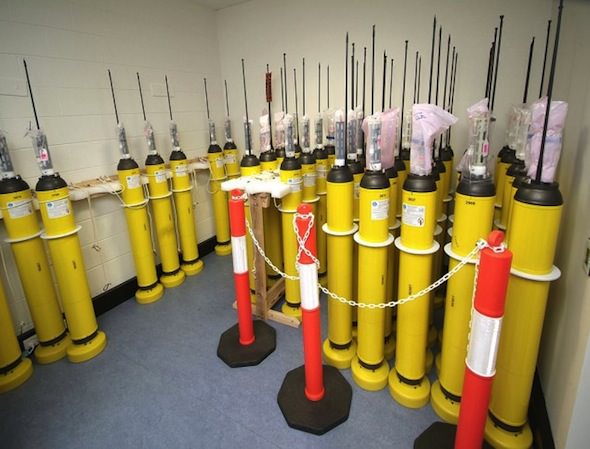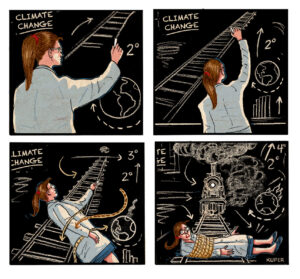Hotter Oceans Explain Global Warming ‘Pause’
Far more heat than suspected is being absorbed by the oceans' top layer, scientists have found, but a study has uncovered little evidence of rising warmth at greater depths.
By Alex Kirby, Climate News NetworkThis piece first appeared at Climate News Network.
LONDON — One of the most hotly-argued questions in climate research – whether global warming has slowed or even stopped – appears to have been definitively answered. And the scientists’ conclusion is unambiguous: the Earth continues to warm at a dangerous pace.
All that’s happening, they say, is that the extra heat being produced – mainly by the burning of fossil fuels – is concentrating not in the skies but in the seas. They have found new evidence that backs them up.
Instead of driving up the temperature of the atmosphere quite as fast as predicted, the evidence shows that the heat from greenhouse gas emissions is warming the oceans much more rapidly than had been realised.
In some regions the water appears to have been warming, for over 40 years, more than twice as quickly as thought, for instance in the upper 2,300 feet (700 metres) of the southern hemisphere’s oceans.
Paul Durack from the Lawrence Livermore National Laboratory in California and colleagues compared direct and inferred sea temperature measurements with the results of climate models. Together the three sets of measurements suggest estimates of northern hemisphere ocean warming are about right.
Serious under-estimate
But the team report in Nature Climate Change their estimate that warming in the southern seas since 1970 could be far higher than scientists have been able to deduce from the limited direct measurements from this under-researched region. Globally, they conclude the oceans are absorbing between 24 and 58% more energy than thought.
The researchers were able to use data from satellites and from a new source – Argo floats, a fleet of more than 3,000 free-floating monitors which drift through the water and measure the temperature and salinity of the upper 6,500 feet (2,000 m) of the ocean.
A year ago, the Intergovernmental Panel on Climate Change published its Fifth Assessment Report. Professor Chris Rapley, a former director of both the British Antarctic Survey and the Science Museum in London, told the Climate News Network then of his alarm at what the IPCC said about the oceans.
He said the Earth’s energy imbalance, and evidence that the 93% of the energy build-up absorbed by the oceans continued to accumulate, meant the slow-down in the rise of surface temperatures appeared “a minor and temporary fluctuation”.
Speaking of the latest research, Profesor Rapley told the Network: “The newly reported results of a combination of satellite altimetry measurements of globally mapped sea level rise combined with ocean heat modelling, and a further analysis of the in situ measurements from the Argo buoys, add to the evidence that the so-called ‘pause’ in global warming is confined to surface temperature data, whilst the planet’s energy imbalance continues unabated.
Cold depths
“Once more we need to assess our appetite for risk, and consider seriously what measures we should take to minimise the threats to food and water supplies, the impacts of extreme weather, and the consequences of these to the world economic system and human wellbeing.”
A second study, also published in Nature Climate Change, by scientists at NASA’s Jet Propulsion Laboratory in Pasadena, California, concluded tentatively that all ocean warming from 2005 to 2013 had occurred above depths of 6,500 feet, and that it was not possible to detect any contribution by the deep oceans to sea level rise or energy absorption.
Josh Willis, a co-author of this study (which like that by Dr Durack and his colleagues results from the work of NASA’s newly-formed Sea Level Change Team) said the findings did not throw suspicion on climate change itself. He said: “The sea level is still rising. We’re just trying to understand the nitty-gritty details.”
This study therefore leaves several questions still unanswered. Will more research find evidence that deep water is in fact warming, for instance? Why are the oceans now apparently absorbing more heat than they once did? And if the southern oceans are heating up faster, then may that help to speed up Antarctic ice melt?
One urgent question that needs answering is how much longer the water near the surface can continue to absorb the extra heat which human activities are producing. Another is what will happen when the oceans no longer absorb heat but start to release it. The answers could be disturbing.
Your support is crucial...As we navigate an uncertain 2025, with a new administration questioning press freedoms, the risks are clear: our ability to report freely is under threat.
Your tax-deductible donation enables us to dig deeper, delivering fearless investigative reporting and analysis that exposes the reality beneath the headlines — without compromise.
Now is the time to take action. Stand with our courageous journalists. Donate today to protect a free press, uphold democracy and uncover the stories that need to be told.






You need to be a supporter to comment.
There are currently no responses to this article.
Be the first to respond.